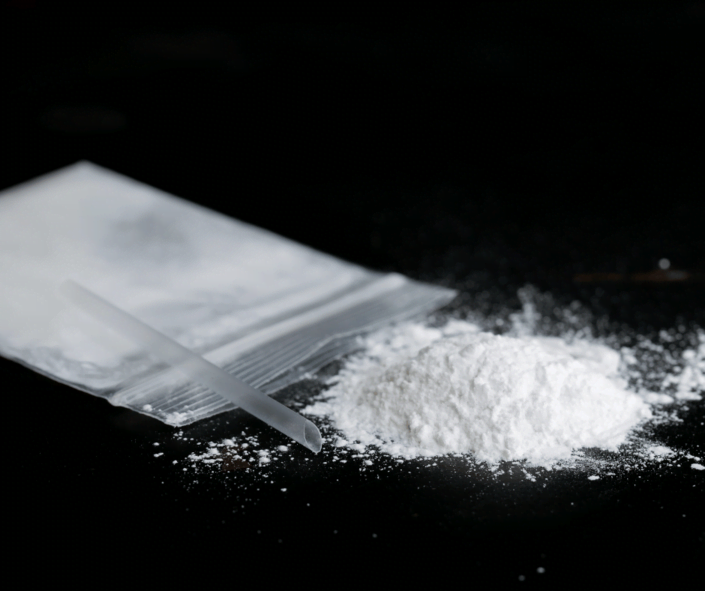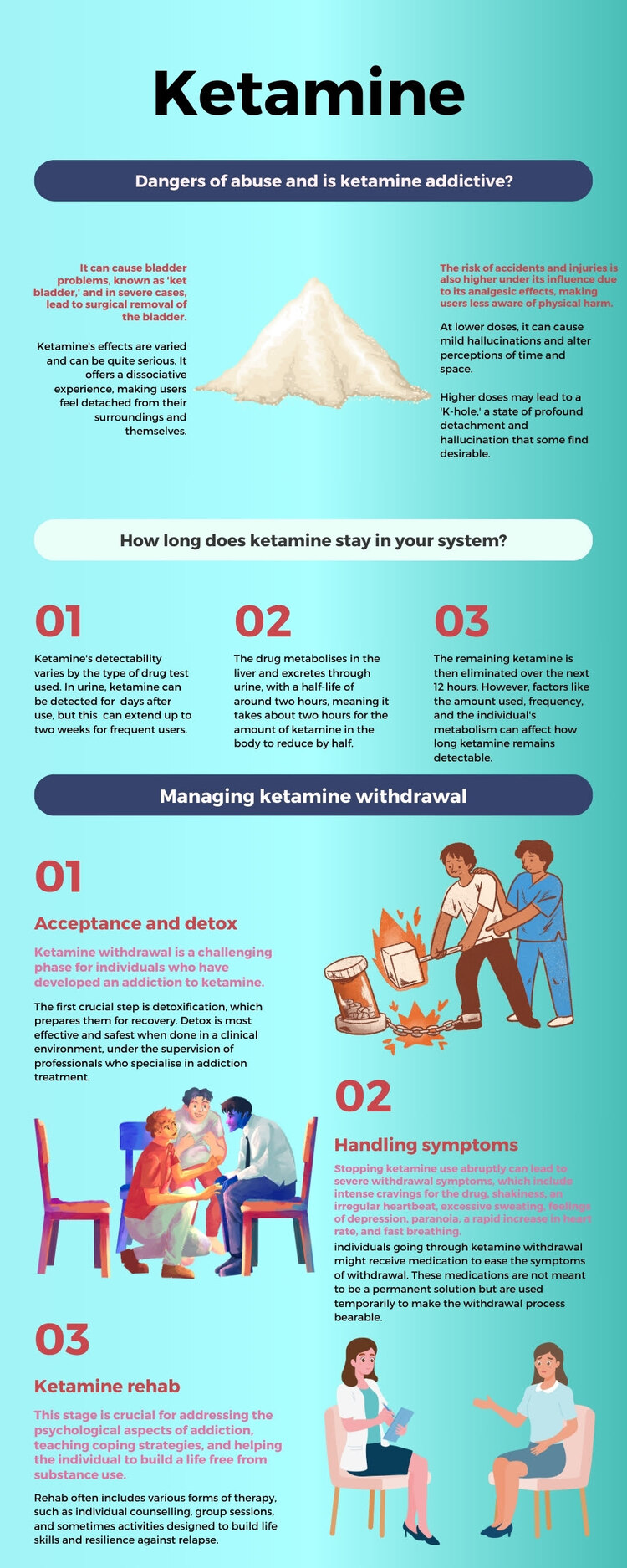
What is ketamine, and is it addictive?
Ketamine was discovered in 1962 as a safer way to help people sleep through surgery without causing too many side effects (also known as a surgical anaesthetic). It’s really good at this because it doesn’t stop people from breathing on their own. This drug was used a lot in hospitals and even by soldiers in the Vietnam War because it worked fast and was safe.
But, like all medicines, it’s important to use ketamine the right way or it can become addictive. Doctors give it in different forms, like a shot or a spray, and it starts working really fast. This quick help can be a game changer for some people. Yet, because it’s so powerful, it’s best to only use it when a doctor says it’s okay.
In short, ketamine has come a long way from just helping people not feel pain during surgery to possibly helping with tough-to-treat sadness or worry. But, it’s key to remember to always use it safely and under a doctor’s watch.
Why is ketamine so popular in the UK among youth?
Party drug in the UK

Ketamine’s journey in the UK is a story that reflects its role in society. About 20 years ago, ketamine started to appear in the UK, initially used within the medical community for its anaesthetic properties.
However, its use quickly expanded beyond medical settings, finding a place in the club and rave scenes. Originally, ketamine was more of an after-party drug, used to extend the night’s experiences in more private settings. But over time, its use in public spaces like clubs and festivals has increased significantly.
Affordability of ketamine
In the UK, ketamine is relatively affordable, costing around £20 a gram, which is significantly less than other popular substances like MDMA or cocaine. This affordability, coupled with its availability through social media and messaging platforms, has made it particularly popular among young people, including students who are navigating high living costs and uncertain job markets.
Is ketamine addictive?
Despite its recreational use, ketamine’s effects are varied and can be quite serious. It offers a dissociative experience, making users feel detached from their surroundings and themselves.
At lower doses, it can cause mild hallucinations and alter perceptions of time and space. Higher doses may lead to a ‘K-hole,’ a state of profound detachment and hallucination that some find desirable.
However, the risks associated with ketamine use are significant. It can cause bladder problems, known as ‘ket bladder,’ and in severe cases, lead to surgical removal of the bladder.
The risk of accidents and injuries is also higher under its influence due to its analgesic effects, making users less aware of physical harm. Furthermore, frequent use can lead to dependence and tolerance (followed by ketamine withdrawal), requiring higher doses to achieve the same effects. Mixing ketamine with depressants like alcohol can be particularly dangerous, increasing the risk of fatal overdose.
Is ketamine legal?
The law in the UK classifies ketamine as a Class B drug, reflecting its potential for harm. Penalties for possession and supply are severe, highlighting the government’s stance on controlling its use. Despite these measures, ketamine’s presence in the club scene and among young people remains substantial, driven by its unique effects and economic factors.
Ketamine’s journey from a medical anaesthetic to a widely used recreational drug in the UK illustrates the complex interplay between drug culture, societal changes, and the ongoing challenges of drug harm reduction. It is a reminder of the evolving nature of substance use and the need for ongoing research, education, and policy-making to address the risks and realities of drug use in modern society.
Is ketamine addictive?
To discuss whether ketamine is addictive, it’s crucial to break down its impact under three categories: effects on brain and body, therapeutic uses, and risks and safety.
Effects on brain and body
Ketamine affects everyone differently. When snorted, it works fast, raising the heart rate and altering perception, similar to psychosis symptoms. Users might feel disconnected, facing speech and movement impairments. Low doses tweak space and time perception, whereas high doses lead to intense hallucinations or as previously mentioned ‘k-hole’, making users lose touch with reality.
Therapeutic uses
Medically, ketamine offers pain relief and is used in anaesthesia. Its ability to induce disassociation and numbness is pivotal in controlled medical environments, aiding various treatments.
Risks and safety
Using ketamine outside a medical setting poses significant risks. The disassociation can be enjoyable for some but distressing for others. High doses, especially, are risky, leading to dangerous levels of disconnection. It’s debated whether ketamine is addictive, but psychological dependence is possible, especially among those seeking an escape from reality. Regarding detection, ketamine can stay in your system for several days, detectable through urine tests.
How does ketamine make you behave?
When someone uses ketamine, they might act very differently. They could pay too much attention to small things or say things that don’t make sense. How ketamine affects a person changes a lot based on how much they take. People who use a little may talk more and feel outgoing.
But if someone uses a lot, they might not respond at all, almost like they’re in a deep sleep.
People who use ketamine a lot might start feeling very sad or anxious. It’s not clear if ketamine makes them feel this way or if they use ketamine because they’re already feeling sad. Using ketamine to get away from stress can lead to more serious drug problems.
They might start to ignore their work, school, or friends. They might use ketamine at bad times or even start using it alone.
Some people might try to stop using ketamine but find they can’t. They might also lie about how much they’re using. Prioritising ketamine over things they used to enjoy is a big warning sign.
Ketamine can make it hard for someone to do well at work or school. They might spend too much money on ketamine, even if they don’t have much money. They might also start avoiding their family and friends because they feel ashamed about using ketamine.
These stories show how using ketamine can change someone’s life. It’s important to notice these signs early. The sooner someone gets help for using ketamine too much, the better their chance of getting better.
What is ketamine withdrawal?
Ketamine withdrawal is a challenging phase for individuals who have developed an addiction to ketamine. This addiction takes a toll on their cognitive abilities, meaning it affects their ability to think clearly and make decisions.
Detoxification
To overcome this, the first crucial step is detoxification, which prepares them for recovery. Detox is most effective and safest when done in a clinical environment, under the supervision of professionals who specialise in addiction treatment.
In such a setting, individuals going through ketamine withdrawal might receive medication to ease the symptoms of withdrawal. These medications are not meant to be a permanent solution but are used temporarily to make the withdrawal process bearable.
They are carefully reduced over time until the individual no longer relies on them, both physically and mentally. Stopping ketamine use abruptly can lead to severe withdrawal symptoms, which include intense cravings for the drug, shakiness, an irregular heartbeat, excessive sweating, feelings of depression, paranoia, a rapid increase in heart rate, and fast breathing.
Professional help
These symptoms of ketamine withdrawal make it clear why professional help is crucial. Without it, withdrawal can be not only uncomfortable but also dangerous. The medications provided during detox are there to mitigate these risks and symptoms, making the process as safe and as comfortable as possible for the person.
Ketamine rehab
This stage is crucial for addressing the psychological aspects of addiction, teaching coping strategies, and helping the individual to build a life free from substance use. Rehab often includes various forms of therapy, such as individual counselling, group sessions, and sometimes activities designed to build life skills and resilience against relapse.
Undergoing detox and rehab in a medical setting has significant advantages for individuals dealing with ketamine withdrawal. One of the main benefits is the absence of access to drug dealers or environments that could trigger a relapse.
Being in a controlled, drug-free environment allows the person to focus entirely on their recovery without the distractions and temptations of their usual environment. This can significantly increase the chances of a successful recovery.
Support for ketamine withdrawal
Furthermore, the support system in a clinical setting such as InnerLife Recovery in Marbella, is designed to provide care and encouragement throughout the withdrawal and recovery process. Addiction specialists, therapists, and medical staff work together to create a personalised treatment plan that addresses the unique needs of each individual. This comprehensive approach ensures that both the physical symptoms of ketamine withdrawal and the psychological challenges of addiction are addressed.
Overcoming ketamine addiction starts with managing ketamine withdrawal through a structured detox process, followed by comprehensive rehabilitation. The journey is undoubtedly challenging, but with the right support and treatment, recovery is possible. The goal of this process is not just to stop using the drug but to build a foundation for a healthier, drug-free future.

How long does ketamine last?
Ketamine’s effects can last for about 1 hour on average, but this can vary. For instance, when snorted, the effects of ketamine typically last around 45 to 75 minutes. The onset of effects is relatively quick, often within 5 to 15 minutes after snorting, and users might not feel back to their normal selves for the rest of the day or evening.
The actual duration can be influenced by factors such as the dose taken, the method of use (e.g., snorting, injecting, or oral consumption), and individual differences like weight and metabolism.
For therapeutic uses, such as in ketamine-assisted therapy, the duration is manageable, fitting into a session of a few hours including preparation and integration talk therapy. Intramuscular injection leads to a quick onset and a shorter overall effect, while oral consumption results in a slower onset and longer duration of effects.
How long does ketamine stay in your system?
Ketamine’s detectability in the body varies by the type of drug test used. In urine, ketamine can be detected for several days after use, but this window can extend up to two weeks for frequent users.
The drug is metabolised in the liver and excreted through urine, with a half-life of around two hours, meaning it takes about two hours for the amount of ketamine in the body to reduce by half.
The remaining ketamine is then gradually eliminated over the next 12 hours. However, factors like the amount used, frequency of use, and the individual’s metabolism can affect how long ketamine remains detectable. Ketamine does not appear in standard five-panel drug tests but can be found through more specific testing.
Ultimately, the experience of ketamine and how long it remains in the body can vary greatly depending on various factors. For therapeutic sessions, the controlled environment and dosage ensure a predictable duration of effects, while recreational use may lead to more variability.
Always considering the impact on health and the potential for detection in drug tests is important for users to keep in mind.
Take action
If you’re grappling with ketamine addiction or withdrawal, or simply seeking more information on managing ketamine use, InnerLife Recovery is here to support you. Our dedicated team offers compassionate, expert guidance to navigate the challenges of addiction and recovery. We understand the complexities of ketamine dependency and provide tailored strategies to empower your journey towards healing.
Don’t face this alone. Visit our contact page today to connect with us. Your path to recovery and understanding starts with a single step. Let InnerLife Recovery be your guide to a brighter, healthier future. Reach out now – we’re here for you.






